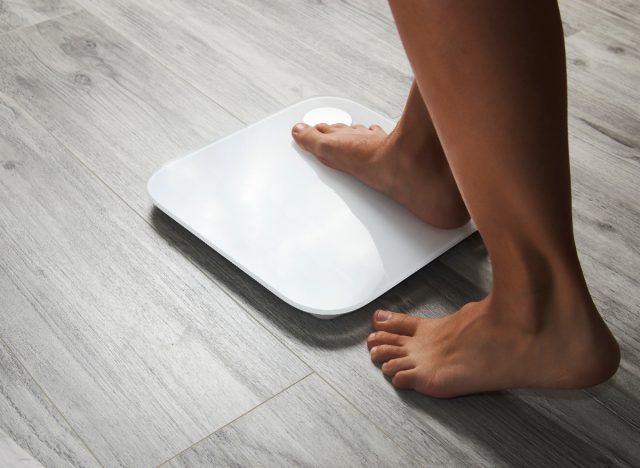When you notice the scale’s not moving, you’re experiencing what’s known as a weight loss plateau. According to the Mayo Clinic, it’s common for your weight loss progress to slow down. Knowing the culprits behind this plateau will put you in a much better position to know how to effectively address it. This will also keep you from picking up any unhealthy habits that’ll throw you off track along the way. We have some of the easiest ways to get the scale moving again after a plateau, so listen up. Keep reading to learn more, and next, don’t miss 5 Little Things You Can Do Every Day To Lose a Lot of Weight.
Why are you hitting a weight loss plateau?

Anthony J. Yeung, CSCS, a fitness expert and the founder of GroomBuilder, tells Eat This, Not That!, “You’ve probably hit a plateau when either the scale doesn’t move or your body fat percentage doesn’t move over a week or two. Typically, this is caused because you’re consuming more calories than you should, you’re not exercising enough, or you’re burned out.”
But don’t stress out! The Mayo Clinic explains that everyone who’s on a weight loss journey will experience a plateau at some point. Even if you’re taking all the right steps, like getting regular physical activity and preparing healthy meals, don’t be shocked if the plateau comes for you. Here’s how you can get the scale moving again after a plateau.
Bump up your fitness.
According to the Mayo Clinic, increasing your workouts is a stellar place to start. Make sure you carve out a minimum of 150 minutes of moderately intense aerobic exercise or 75 minutes of vigorous aerobic exercise each week, or opt for a combo of the two. If you want to reap even more benefits of physical activity and speed up your weight loss progress, getting in a minimum of 300 minutes of exercise each week is the suggestion. Be sure to incorporate weight lifting into your routine to bump up your lean muscle mass and torch a greater number of calories, as recommended by the Mayo Clinic.
In addition, you don’t have to be working up a sweat at the gym in order to boost your physical activity. Consider walking or riding a bike into town—if you can safely do so—when running errands, or park your car further so you can get in more steps to where you need to go. Work some simple exercises into your house cleaning, take your pup on a hike or play a round of fetch, walk around your neighborhood when taking calls, and increase the amount of yard work that needs to get done. All of these little things can add up to make a big difference.
Track your calories.

According to Yeung, the simplest way to get the scale back to moving in your favor is by tracking your calories. He explains, “Track how many calories you’ve been eating every day and then reduce that by 250 each day. Then assess by the end of the week to see if you’re losing fat again.”
There are so many apps out there nowadays that can help you stay on top of your daily calorie intake, so consider downloading one of them to get started!
Take a break, and have a “refeed” meal.
If you’ve already cut calories in your routine and you’re not noticing any difference or progress, Yeung has another suggestion. “Try taking a break and having a ‘refeed’ meal where you load up on carbs to spike your leptin levels,” he explains. “Remember: You can’t just constantly cut calories week after week; you must take a break every few weeks to keep your hormone levels at optimal levels so that your metabolism stays high.”
Alexa Mellardo


